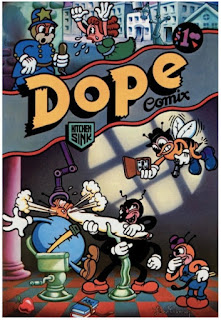GCD
Front cover: Dennis Fujitake
TCJ Archive
Back cover: Wendy Pini
THE COMICS JOURNAL 50 (October 1979) Twenty-fifth Gary Groth-edited issue!
Executive Editor: Gary Groth
Editor/Circulation Director: Kim Thompson
Consulting Editor: J. Michael Catron
Assistant Editor: Robert H. Boron
Correspondent (UK): John Dakin
Correspondent (Undergrounds): Bruce Sweeney
1. NEWSWATCH: Undergrounds
Bruce Sweeney and company dug up some new releases that are hard to find today! All hail the Poopsheet Foundation! Rick Bradford's database is essential in researching these mini-comics from the dark ages of the 70s.
GCD
GCD
Last Gasp
Internet Archive
GCD
Heritage Auctions
Poopsheet Foundation
Internet Archive
Poopsheet Foundation
Poopsheet Foundation
mycomicshop.com
Head Comic Wiki
GCD
Worthpoint
Poopsheet Foundation
2. NEXT ISSUE: Wildman & Rubberoy by Richard "Grass" Green
3. BLOOD & THUNDER: R.C. Harvey responds to the Greg Potter Will Eisner article from The Comics Journal 47.
The Met Report, 2013
"The art of the comics is not so much in their stories and themes as it is in the storytelling. It's how the stories are told - with pictures as well as words - that reveals the craft and the art of the medium. If your reviewers adjust their sights to their perspective, they might enjoy more what they're doing. They might even find some minor masterpieces on the newsstand. And then when a Dickens or Tolstoy finally emerges on the pages of the comics, your reviewers will be in a good position to properly appreciate his entire accomplishment - not only the affecting themes of a powerful story but the art (both verbal and visual) involved in telling that story."
4. COMICS REVIEWS: The Crusaders 1-9 by Cat Yronwode
This whole series is still available in print and digital format from Chick Publications, which is still pumping out content to save all our lost souls (as a Catholic, pretty sure I'm only a few steps up from Satan in their eyes) despite Jack T. Chick passing in 2016. The artist on most of these has since been revealed as the talented, unsung African-American cartoonist Fred Carter.
GCD
From Cat Yronwode's review: "As noted above, every story has an obligatory airplane scene. In addition, each one has, at the climax of the story, right where the fight would be in a standard comic, one or more obligatory conversion scenes. 'Conversion' is a technical term for a person deciding that his life has been a failure and deciding to enlist in the forces of God. This is accomplished by a process known as 'accepting the Lord Jesus into your heart' and results in tearful joyousness and relief. Most people resist conversion out of a desire for self-determinism. It is the secondary mission of the Crusaders to convert anybody they can. Thus, in the middle of their cat-and-mouse game with the KGB in Bucharest, they score a real coup by converting a Russian spy. In #9, 'Angel of the Night,' they convert two hippies who have narrowly escaped being killed by psychopathic killers. One of the most interesting conversion scenes takes place in 'The Broken Cross,' when a cannibalistic teenager named Jody is converted and subsequently kidnapped by the Satanic town sheriff and his leader, a Christian preacher. The men are actually double agents working for satan, but Jim [a Crusader] overpowers them by calling the Lord's name and causing them to vomit."
5. DOC'S BOOKSHELF: The Gods From Outer Space by Dwight R. Decker
Dwight Decker uncovers a real outlier in these early days of European comics translations, a German comic put out by Dell Publishing. A bonus is the subject being a fictionalized graphic novel based on Erich von Daniken's equally fictitious ancient astronauts theories!
English-language, GCD
German-language: GCD
"Now, however, some years after the crest of the Von Daniken wave, a West German publisher, Bastei-Verlag, has released the first issue of what promises to be a series of comics based on the 'Gods' theme [there turned out to be eight albums in the series from 1978-83]. That this is the authorized version there can be no doubt: an inset photo of Erich von Daniken himself appears on the cover next to the words, 'based on the work of Erich von Daniken,' the copyright is held by Econ-Verlag (Von Daniken's regular publisher), and the translator of the English-language version is Michael Heron (who has translated all of Von Daniken's books to date).
"The Gods From Outer Space certainly looks impressive. The size is standard European soft-cover album format (the English edition is about 8 1/4" x 11 1/4"; the German edition was slightly larger) with 48 interior pages. The art is generally good, if a little stiff, and the printing and colour work are excellent. Not a bad buy for $1.95 these days. "





%20%5BArchival%20Press%5D%20(Sir%20Real)_0000.jpg)



%20(watermarked)%20(tunafan)_0000.jpg)















































